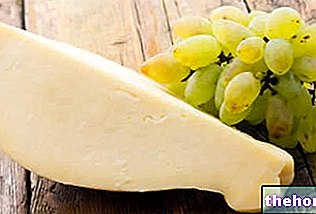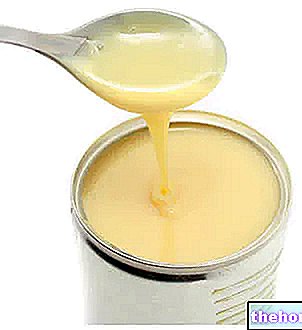Milk: maternal and animal
Milk is a food of animal origin secreted by the mammary glands of mammals-female, useful for the nutrition of the offspring during the first months of life (in humans about 6); milk changes composition over time and, giving for granted the good state of health (both of the nurse and of the progeny) it follows and fully complies with the specific nutritional requirements of the first development.
- The composition of breast milk is different:
- Among the mammalian species
- Between individuals
- In the various stages of weaning
It follows that, during lactation, milk is an essential food source and NOT replaceable by the equivalent of another "animal breed."However, in case of need, the breast milk of a female who does not possess the necessary requisites for weaning her offspring (quantitatively and / or qualitatively insufficient secretion, gland infections, systemic infections, etc.), can be replaced with that of another. female of the same species.

Although milk is an irreplaceable source of sustenance in the first months of weaning, for the rest of life it represents a useful but not essential food.
Man, with significant differences between populations, has always consumed animal milk by virtue of its nutritional properties. It contains very important ions and molecules, such as calcium (Ca) and vitamin B2 (riboflavin), but also energy molecules that , in industrialized countries, the human being should significantly limit: saturated fat and cholesterol. It can be deduced that animal milk (usually cow's milk) represents a food source in some ways USEFUL, BUT not always indicated in large quantities.
In order to limit the intake of saturated fats and cholesterol with milk, the dairy industry provides consumers with some less lipid-rich milks (which are then reused in the production of other derivatives): semi-skimmed and skimmed milk. ; they also bring less fat and calories and, in the most extreme cases, can be indicated in the diet therapy of hypercholesterolemia as well as obesity. What not everyone knows is that cow's milk marketed with the wording "whole", while representing the most caloric derivative, is NOT the "original" emunctory product of the cow, which instead is defined raw milk.
Raw milk VS whole milk
Until recently, raw milk was sold exclusively at the milking site: in the stables; today, farmers have created a "short chain" distribution method based on the daily supply of refrigerating automatic dispensers that store milk between 0 and 4 ° C (price: about 0.80 euro cents / liter).
Raw milk is whole (with respect to the fat content) but does NOT undergo any processing process other than MACRO-filtration; on the contrary, the whole milk is previously centrifuged and skimmed (to obtain skim milk) and added again with its own fats homogenized (homogenization). This process allows you to:
- Facilitate the production of different milks with different skimming levels
- Promote the emulsion of the lipid fraction which tends to resurface in raw milk "at rest"
- Increase its digestibility
Raw milk, compared to whole milk, at the time of purchase has all the "original" nutritional qualities (thermolabile components: enzymes and vitamin D) and the protein fraction is slightly more digestible; however, the fat micelles remain totally INTEGRAL, prolonging notably the digestibility of the food. On the contrary, whole milk is proportionally depleted with respect to the type of heat treatment applied; most commonly: fast pasteurization High Temperature Short Time (HTST - called "fresh milk" - less storable) e Ultra High Temperature treatment (UHT - called long-life); however, thanks to the homogenization of the lipids, it boasts an absolutely greater digestibility than raw milk.
In light of the above, it seems that raw milk, in addition to having a greater palatability, is nutritionally more integral even if less digestible; in truth, this affirmation is only partially acceptable raw milk, which is only MACRO-filtered, constitutes a food potentially contaminated (even if the animals are subjected to veterinary control 2 times a month), then It CANNOT or should NOT be eaten raw; statistically, about 1/5 of the analyzed samples contain pathogens and, obviously, a similar condition NEEDS the food sanitation of the product. Ultimately, at the time of purchase, raw milk is certainly "richer" than whole milk but, for hygiene reasons, it MUST be boiled by the final consumer (see the information of the Italian Ministry of Health for this purpose. ); unfortunately, home boiling significantly affects both the nutritional and gustatory quality of raw milk which, not being homogenized, continues to be less digestible than fresh whole milk.
In conclusion, the difference between raw milk and whole milk consists in the "nutritional intake of the food at the time of purchase" (higher in raw milk) and digestibility (higher in whole milk). The color of sanitized raw milk is dark and the totally different taste, but on the other hand, sanitation is highly recommended to reduce the risk of food poisoning.
Excluding the voluntary and conscious risk of consuming raw milk NOT heat treated, from a nutritional point of view there are no reasons to prefer boiled raw milk over whole-fresh or whole-UHT milk.
Milk, Dairy Products and Cheeses Asiago Brie Burrata Caciocavallo Rennet Camembert Cheddar Milk Cream Crescenza Emmental Feta Milk Flakes Fontina Herbal Cheeses Lean Cheeses Cheeses rich in calcium Gorgonzola Gouda Grana Padano Gruyere Kéfalair Adapted milk Artificial milk Condensed milk Asphyxiated milk Goat's milk Sheep's milk Rice milk Soy milk Powdered milk and concentrated milk Skimmed and semi-skimmed milk Lactose-free milk Milk Vegetable milk Dairy products Lerdammer Mascarpone Montasio Buffalo mozzarella Mozzarella Whipped cream Cooking cream Fresh cream Parmigiano Reggiano Pecorino Philadelphia Primo Sale Provolone Ricotta Robiola Roquefort Scamorza Sottilette Squacquerone Taleggio Tomino Yogurt OTHER ARTICLES MILK AND DERIVATIVES Categories Alcoholic foods Meat Cereals and derivatives Sweeteners Sweets Offal Fruit Dried fruit Milk and derivatives Legumes Oils and fats Fish and fishery products Cold cuts S pezie Vegetables Health recipes Appetizers Bread, Pizza and Brioche First courses Second courses Vegetables and Salads Sweets and Desserts Ice creams and sorbets Syrups, liqueurs and grappa Basic preparations ---- In the kitchen with leftovers Carnival recipes Christmas recipes Light diet recipes Women's Day, Mum, Dad Recipes Functional Recipes International Recipes Easter Recipes Recipes for Celiacs Recipes for Diabetics Recipes for Holidays Recipes for Valentine's Day Recipes for Vegetarians Protein Recipes Regional Recipes Vegan Recipes




























